Galway and Salthill Tramway
History
Powers to construct a tramway between Galway and the nearby seaside resort of Salthill were granted on the 14th August 1877, under the Galway and Salthill Tramways Act, 1877. The act also incorporated a company — the Galway and Salthill Tramways Company — of which the promoters, two of whom were named, would become directors.
The promoters seem to have had difficulty raising the capital to build the line, and at some point attempted to secure further legislation to enable the use of steam traction, the 1877 Act only permitting the use of horse traction. There is no record of a bill being discussed in parliament, so it seems more than likely that the attempt did not proceed very far. Around February 1879, the original promoters sold the rights, new directors taking up their company positions on the 29th March 1879. The new owners circumvented the lack of local capital by securing a deal with two English tramway contractors (Winby and Ridley) to construct the tramway (including the provision of tramcars and horses) in exchange for shares in the company, no public offering of shares having at that point taken place.
Construction started on the 21st July 1879, the tramway opening just over two months later on the 1st October 1879. The tramway, which was circa 2.12 miles long, was built to a gauge of 3ft 0ins, and was initially operated by six Starbuck-built horsecars. The Galway terminus was in Eyre Square, from where it ran southwestwards — via Shop Street and Bridge Street, then over the River Corrib (by West Bridge), along Dominick Street (Upper and Lower), William Street and Salthill Road — to a terminus just short of the Eglinton Hotel in Salthill. Although there was also a short section of line between the depot (off Forster Street in Galway) and Eyre Square, it is very unlikely that passenger services were ever operated over this stretch. The line effectively remained as built save for a couple of very short extensions at the Salthill end of the line, which eventually took the terminus to just beyond the Eglinton Hotel.
The tramway was well used, with the company paying dividends of around 3.5% during its early years, though the profit overwhelming came from the operation of summer services. The company always faced difficulties with the significant drop-off in custom during winter, reducing the number of men and horses, then struggling to acquire new horses and men the following spring.
No dividends were paid for much of the 1890s due to significant expenditure (on maintenance and renewal) and a run of poor summer weather, the company operating at a loss, and expending all its reserves. By the late 1890s, however, the outlook became brighter, and by 1902 the debts had been cleared and the company was back in the black. Although there was much talk about converting the system to electric traction, realistically speaking, the company was never in a financial position to bring this about, and could only have managed it by selling the concern to a company with the necessary capital. In the absence of a suitor, the horse tramway soldiered on, six new horsecars replacing the older vehicles between 1909 and 1911, with small dividends continuing to be paid.
The Great War saw the requisition of a significant number of the company's horses (by the War Department), the company having no choice but to reduce its services accordingly. Costs increased dramatically towards the end of the war, such that the tramway was again operating at a loss. With no realistic prospect of a change in fortunes, two of the directors attempted to wind the company up in late 1917, but were prevented from doing so by a point of law, the pair having failed to call a general meeting of the company beforehand. This was, however, just a short stay of execution, an Extraordinary General Meeting of the company taking place on the 19th January 1918, at which a vote was carried to voluntarily wind up the company. The company's winding-up order was heard by the High Court on the 26th February 1918.
The tramway is believed to have closed on the 12th May 1918, though this may well be the date that the assets were sold, so there is a distinct possibility that it closed days or even weeks beforehand.
Uniforms
Commentators at the time of the opening (1st October 1879) described the staff as being "arrayed in handsome uniforms". Fortunately, a photograph that was probably taken on the day has survived; this shows two conductors wearing three-quarter length, single-breasted jackets with stand-up collars, along with kepi-style caps. Although no insignia is in evidence, this may well be due to the poor quality of the image.
These uniforms appear to have been short lived, as photographs taken from the mid 1880s onwards show tramcar crews wearing informal attire, i.e., jackets, shirts and ties, along with the fashionable headgear of the day, initially the bowler hat, and later on the flat cap. There is no evidence to suggest that any badges, including licence badges, were worn.
Documentary evidence indicates that parcels boys were also employed, as unfavourable comment was passed on their appearance, so presumably no uniforms were provided to them.
The Galway and Salthill Tramway Company certainly employed the services of an inspector, though whether he wore a uniform or not remains unknown.
It is believed that the company, like other Irish tramways, did not employ women during the Great War.
Further reading
For a history of the system, see: 'Galway and Salthill Tramway' by A T Newham, in the Tramway Review, No 39 (p155-171); Light Railway Transport League (1964). For an overview of the Irish tram scene, including the Galway and Salthill line, see 'Irish Trams' by James Kilroy; Colourpoint Books (1996).
Images
Horse tram drivers and conductors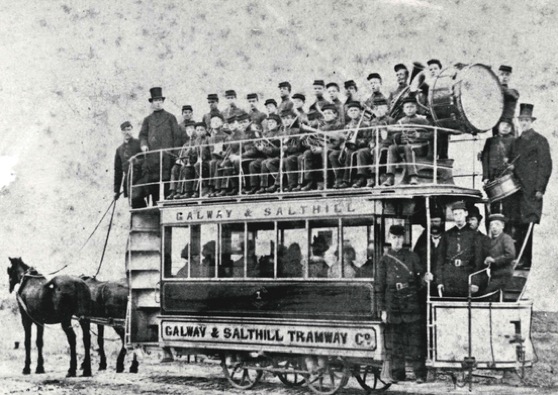
A rare early view of Galway and Salthill Tramway Horsecar No 1 — photo undated, but very probably taken on the opening day, i.e., the 1st October 1879.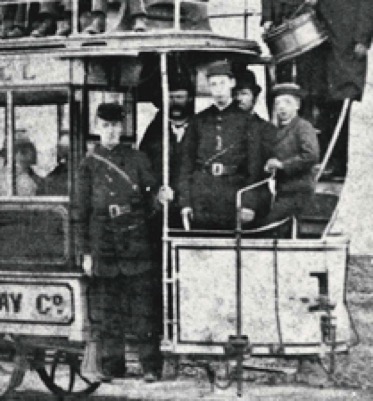
An enlargement of the above photograph showing the two conductors; the driver is holding the reins at the front of the vehicle (out of shot). Although of poor quality, it is nevertheless good enough to show the three-quarter length, single-breasted jackets, and kepi-style caps.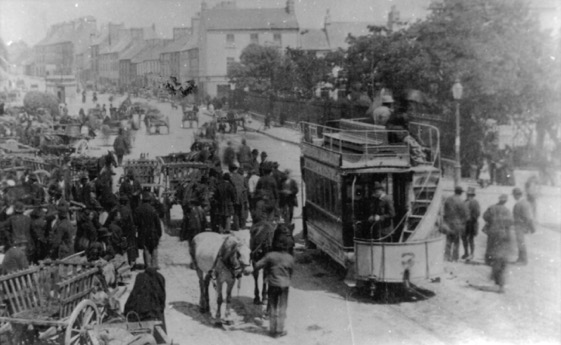
An early and wonderfully evocative view of G&STCo Horsecar No 3 making its way through an extremely busy Eyre Square, on what may well have been market day — photo undated, but judging by the fashions on display, which include a stovepipe style of hat, probably taken in the early 1880s. Photo courtesy of the Tramways and Light Railway Society, with thanks to David Voice.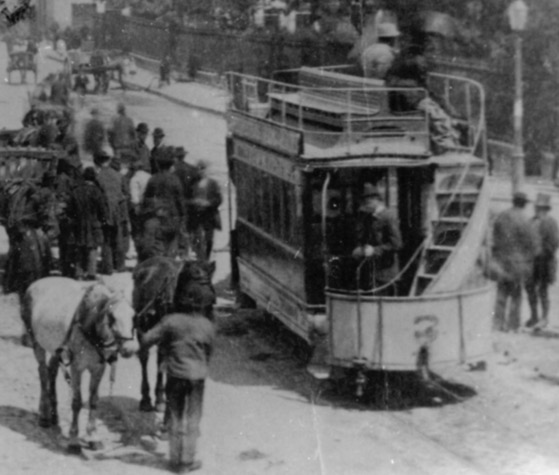
An enlargement of the above photograph showing the conductor on the rear platform; he is wearing informal attire and a bowler hat.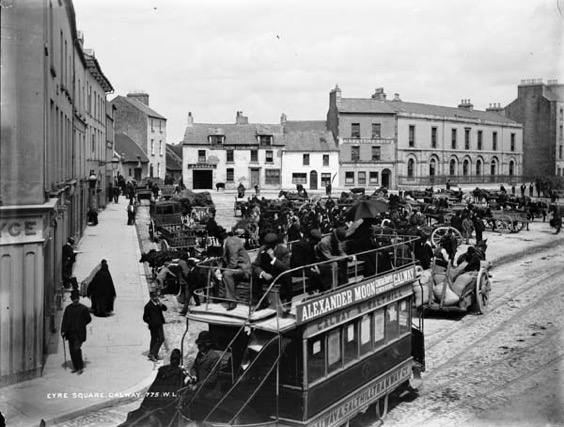
Another busy shot of Eyre Square with a driver at the helm of Horsecar No 2 — photo undated, but probably taken in the 1880s. Original photograph held in the National Library of Ireland.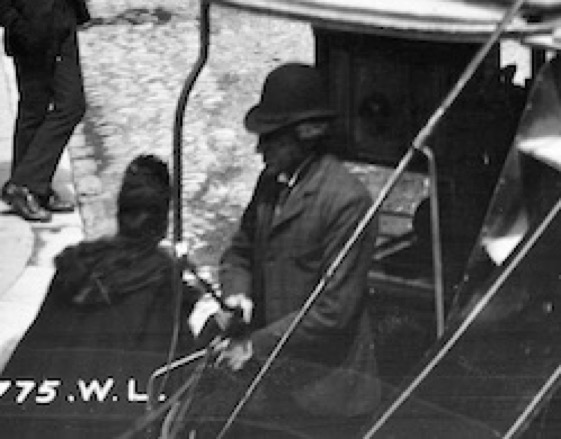
An enlargement of the above photograph showing the driver, in smart jacket, shirt and tie, and a style of bowler hat much favoured in the 1880s.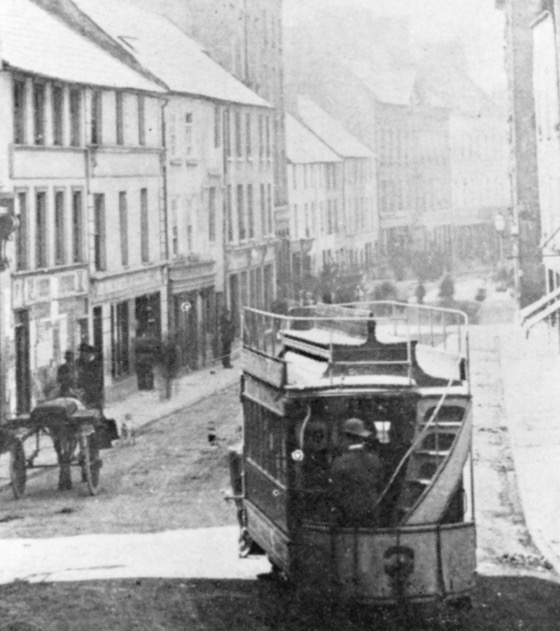
A G&STCo horsecar in what is probably Shop Street, Galway — photo undated, but possibly taken in the 1880s or early 1890s. The conductor is wearing a style of bowler hat (with a curved brim) that was very fashionable in the 1880s. Photo courtesy of Jim Kilroy, tram archivist at the National Transport Museum (see link).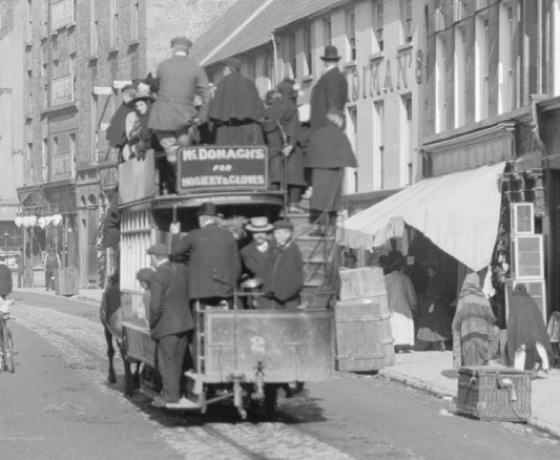
Another evocative scene, this time of Horsecar No 2 in Shop Street around 1910. The conductor is standing on the extreme left of the platform step; he is wearing an informal jacket and a flat cap. Original photograph held in the National Library of Ireland.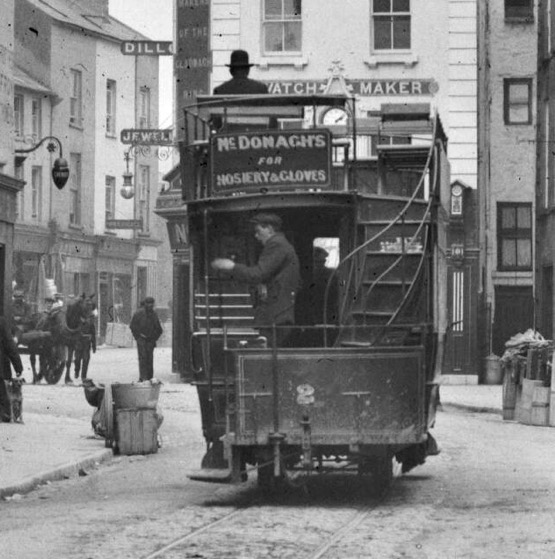
Another shot of Horsecar No 2, this time in Williamsgate Street — photo undated, but probably taken around 1910. The conductor is once again wearing a flat cap. Original photograph held in the National Library of Ireland.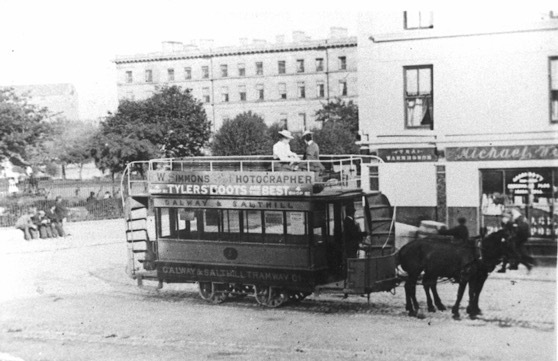
Tramcar No 3 captured in Eyre Square in Galway around 1912. Although difficult to make out, the driver is wearing informal attire and a flat cap. Photo courtesy of Jim Kilroy, tram archivist at the National Transport Museum (see link).